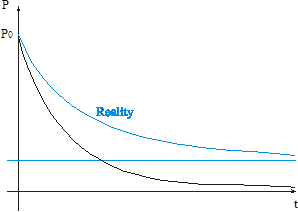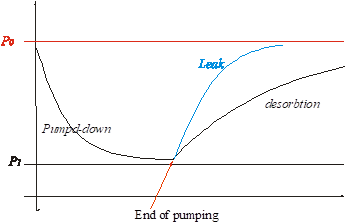PART I. VACUUM METODS
1. VACUUM FUNDAMENTALS
High vacuum = low pressure of gas
Physical problems in vacuum techniques = physics of gases, classical approximation (no quantum effects). Molecular kinetic gas model.
Applications of vacuum in the experiments:
Physics of gases: Free and Bounded (on the surface and in the volume) gas. Vacuum problems – classical kinetic molecular gas models. No quantum effects. Gas molecules behave like elastic mechanical particles moving due to thermal energy.
Remember:
Avogadro number: NA = M0/m0 = 6.1023 mol-1;
M0 = molecular mass, m0 = mass of a molecule
Thermal energy and moving gas particles:
(1) ![]()
where the value of ![]() is depended on the choice of v:
is depended on the choice of v:
v=vvpr the most probable velocity, c1=k=1.38 10-16 erg/K
v=var arithmetical average velocity, c1=(4/p)k
v=v2av mean square velocity, c1=(3/2)k
Example: nitrogen molecules @ 300 K:
vvpr = 400 m/s
var = 450 m/s
v2av = 490 m/s
The mean free path (![]() ) is proportional to:
) is proportional to:
(2) ![]() [cm],
[cm],
n1 - concentration of gas molecules cm-3 , d-diameter of the molecule [cm]
Example: the mean free path of air (Ar, N2, O2 ; d~3.7 10-8 cm) @300K.:![]()
Table1: mean free path for air (T»300k)
|
760 |
1 |
10-3 |
10-9 |
|
2.5*1018 |
3.3*1015 |
3.3*1013 |
3.3*107 |
|
6.6*10-5 |
0.05 |
5 |
5*106 |
The frequency of collision of gas molecules with the wall![]() is proportional to concentration and velocity:
is proportional to concentration and velocity:
(3) ![]()
when f1 [s-1cm-2], n1 [cm-3], v=vav then : c3 = 0.25
The momentum transfer at an elastic collision with the wall: m0v-(-m0v)=2m0v.
The force on a unit surface (pressure) pressure is:
(4) ![]()
where ![]() is a proportionality constant that depends on the choice of pressure units and the definition of the velocity.
is a proportionality constant that depends on the choice of pressure units and the definition of the velocity.
conversion table: to be inserted
Express m0v2 as a function of T . From (4) we have ![]() and since
and since ![]() we get
we get
(5) ![]()
when T [K], p [Tr], n1 [cm-3] then: ![]() =10-5 and:
=10-5 and:
(6) ![]()
From (5) we can get for the concentration![]() :
:
(7) ![]()
For Air (d~3.7 10-8 cm) l0 ~ 1.6 T [K] / p [Tr] . At room temperature l0 (300K) = 5*10-3 / p [Tr].
N.B. In a closed container a temperature change will not change l0 since simultaneously the pressure is changing.
Table 2: Air - components
|
% vol.’ |
% weight |
p[Tr] |
N2 |
78 |
75.5 |
590 |
O2 |
20.95 |
23.14 |
160 |
Ar |
0.93 |
1.25 |
7 |
CO2 |
0.03 |
0.05 |
0.25 |
Ne |
0.002 |
0.001 |
0.014 |
He |
52*10-4 |
72*10-5 |
4*10-3 |
H2 |
5*10-5 |
5*10-6 |
4*10-4 |
Air pressure changes with altitude.
Table 3: atmospheric pressure vs. altitude
Alt.[km] |
0 |
14 |
30 |
47 |
78 |
100 |
200 |
480 |
p[Tr] |
760 |
100 |
10 |
1 |
10-2 |
10-4 |
10-6 |
10-8 |
In between the sea level and about 14 km pressure changes almost linearly with the altitude.
For calibration of pressure meters an absolute meter is needed as a reference.
Vacuum classes corresponding pressure ranges
Forvacuum (technical) p>10-3
Low vacuum (LV) 10-3>p>10-6
High vacuum (HV) 10-6>p>10-9
Ultra high vacuum (UHV) 10-9>p>10-12
Extremely high vacuum p<10-12
“Clean” and “dirty” vacuum: possible contaminations water, oil, specific contaminations, helium, noble gases, hydrogen.
The product Q=pV is referred to as an the amount of gas in pV units [Tr*l], [Pa*m3], etc.
Boyle- Mariotte`s law (B-M law):
(8) ![]()
![]() ,
, ![]() ,
, ![]() mass of a gas molecule
mass of a gas molecule
from (5) we have :
(9) ![]() ,
,
and we obtain the B-M law for the amount of gas (Q):
(10) ![]()
Introducing the universal gas constant ![]()
(11) ![]() .
.
Expressing m in [g], M0 in [g/mol], T in [K], p in [Tr], and V in [l] R=62.37.
In other units R=8.32 104 J/(mol *K), etc.
Intensity of flow is defined as an amout of gas (Q) flowing in a unit time by a cross-section perpendicular to the direction of the flow:
(12) ![]()
Using B-M law we have: (13) ![]()
were n=nm0 stands for the number of gas particles.
The velocity of flow S is defined as: ![]()
Units of S; [m3/h], [l/s]. etc.
(14) ![]()
From (14) we get the relation (16) ![]()
Consider an opening leading to an ideal vacuum (ideal pump). The factor which determines the escape intensity (pumping intensity) is the number of collusion with the opening per unit time,
Using 3 and 13 we get for the intensity:
(17) 
f’- number of gas particles hitting a unit surface in a unit time, p – pressure in the pumped volume.
Using (16) we obtain the velocity of flow through an opening of an area A:
(18) ![]()
Observe that the velocity of flow (pumping speed) decreases with increasing mass of gas molecules, temperature and evidently is proportional to the surface of the opening.
Example: @300° K SA for Air (m0~ 5*10-25 g) = 11.7 A, while for H2 (m0~ 3.4*10-24 g ) SA » 45A .
1.1.9. Change of pressure at a constant velocity of flow.
Consider a container of a constant volume V that is connected to a pump with a constant pumping speed S. How pressure in the container changes in time?
From (13 ) ![]() , and, on the other hand
, and, on the other hand ![]() , therefore
, therefore
![]()
and since number of particles is proportional to the pressure we can write
(19) ![]()
Thus pressure exponentially drops to zero with elapsing time. In the experimental reality we do not have an ideal vacuum. There is some finite limiting minimum pressure p¥ available with a particular pump:
(20) ![]()

Consider an inverse process. We pump down, and after a time t stop pumping:
 p
p
This can be employed to check for leaks in the system.
There are three distinct regimes of flow in tubes.
In this regime the free path of the gas is longer than the diameter of the tube. Each particule behaves individually. There are almost no collisions between the molecules. Thy collide mostly with the walls of the tube. After a collision the particle velocity direction is random and therefore part of the molecules is “back-scattered” towards the input. In this case the effective mean free path is
For air we have molecular flow for ![]()
Most of the collisions are between the molecules. The flow has a velocity distribution with the maximum in the center of a tube.

The flow is laminar as long as ![]()
Laminar flow is characterized by low Reynolds number.
![]()
![]()

![]()
![]()
Speed of pumping of an ideal pump (opening to an ideal vacuum) is given by (18). However, when the opening is connected to the pumped volume by a tube the pumping speed is reduced due to a resistance to the gas flow in the tube. This is due to a friction resulting from collision of molecules with the walls and between themselves.
The longer and the narrower is the tube, more collisions, the higher is the resistance for the flow W.
Tube resistance W follows from the difference in flow velocities
![]() .
.
Note that only for when ![]()
![]() and W=0.
and W=0.
Usually one defines the conductivity of a tube, ![]() , units of G: [l/s]
, units of G: [l/s]
For a cylindrical tube with L>5D one can use the following approximation:
 (D and L in cm)
(D and L in cm)
For air @300K
![]() .
.
Example: A circular tube with D=1cm and L=10cm has a conductivity of G=1.22l/s for Air at 300K. If this tube is connected to the opening of the same diameter leading to the ideal vacuum the speed of pumping of the opening will be S=9l/s. The speed of pumping at the tube inlet will be however:
![]()
N.B. Even such a short tube reduces the speed of pumping from 9 l/s to 1.1 l/s! Proper design of vacuum systems and pumps: short and wide tubes (large apertures create however other problems).
For an opening: the velocity of escape through an opening = the aperture (hole) conductivity G0=1/W0 Since the impedance of a hole is not zero, in general, the resistance of a tube is:
![]() , thus even for
, thus even for ![]() ,
, ![]()
Similarly to electrical circuits:
![]() for a serial connection, and
for a serial connection, and
![]() for a parallel connection.
for a parallel connection.
1.1.11.2 Pumping speed at the other end of a tube.
S- pumping speed, G- tube conductivity and the pumping speed at the other end of a tube
![]() ,
,
Therefore, for G>>S the pumping speed S=S` and is not reduced by the tube. However, when G<<S then S`=G and the pumping speed is limited not by the pump used but by the piping. Always adjust pump to the tube and/or the tube to the pump.
![]() p(d)
p(d)


![]()
![]()
Gas molecule departing from the surface. Angular distribution of velocities of desorbing molecules.
The time of permanence on the surface:
![]()
is the time it takes for a molecule to detach itself from the surface (desorption). ![]() is the temperature of the surface,
is the temperature of the surface, ![]() and
and ![]() depends on the molecule and the surface. For higher surface temperature the time for detachment decreases.
depends on the molecule and the surface. For higher surface temperature the time for detachment decreases.
In free and clean surface the first layer of gas molecules is bonded by metallic bonds (exchanging of electrons). Next layers are attached by atomic (covalent) bonds (deformation of electrons orbitals).
Noble gases – van der Waals bonds – weaker bonds “physical bonds”
Bonding energies (![]() ) in kcal/mole for a clean W surface
) in kcal/mole for a clean W surface
He |
Kr |
H |
CO2 |
O |
O2 |
N2 |
N |
2 |
4.5 |
74 |
122 |
147 |
194 |
85 |
155 |
![]()
![]()
Permanent permanence of the gas molecule on the surface. In the act of absorbtion a latent heat of absorbtion is released and the gas particle remains bounded. For this reason it is hard to absorb noble gases – low energy of bonding.
1.2.2.1. Attachment coefficient and the degree of covering the surface
The frequency at which gas molecules are hitting the surface is
 ,
,
but only a fraction of those hits are effective (in a sense of attachment to the surface), ![]() , where
, where ![]() is the attachment coefficient.
is the attachment coefficient.
The degree of covering is ![]() , where N is the number of particles located on the surface,
, where N is the number of particles located on the surface, ![]() is the number of the available sites on the surface. With increasing
is the number of the available sites on the surface. With increasing ![]() ,
, ![]() decreases. The absorption speed depends on p, T, and the surface state through the coefficient g.
decreases. The absorption speed depends on p, T, and the surface state through the coefficient g.
The time of total surface covering

For air @ 300K and for ![]() =0.5,
=0.5, ![]() , meaning that
, meaning that
The intensity and velocity of adsorption / desorption from the surface A exposed to an ideal vacuum
![]()
The velocity of adsorption/desorption ![]() .
.
For air at 300K, ![]() .
.
The effective absorption frequency was given in the previous section. For the desorption frequency
![]() , where N is the number of molecules on the surface.
, where N is the number of molecules on the surface.
In equilibrium ![]() , and we can solve for N:
, and we can solve for N:
![]()
Equilibrium vapour pressure above a surface of a material is
![]()
insert graph of the vapour pressure vs temperature for various materials.
Insert table of melting and boiling temperatures of various elements.
1.2.4. Materials for vacuum systems
MOOV
1H13N9T and 1H13
Noble gases: Henry`s low: ![]() , where
, where ![]() is the quantity of gas in pV units referred to 760 Tr and 1cm3.
is the quantity of gas in pV units referred to 760 Tr and 1cm3.
Diatomic gases: Sieverst’s low : ![]()
Notice that solubility coefficients ![]() and
and ![]() have different units. These coefficients are temperature dependent. In general increase with temperature, stronger for metals than for glass.
have different units. These coefficients are temperature dependent. In general increase with temperature, stronger for metals than for glass.
For glasses: r1 ~0.005 – 0.01 in the temperature range (20-400o C)
For metals: r2 ~ 0.001- 1 in the temperature range (200-1000o C)
The dissolved gas moves in solids by diffusion:
 .
.
The amounts of gas that penetrates through 1cm2 along the distance L in 1s is:
![]()
![]()
The permeability coefficient is defined as:
 ,
,
insert graph and 2 tables
General requirement for vacuum materials: low permeability!
Source: http://physweb.bgu.ac.il/COURSES/ExperiMethods/lecture_notes/1_1_Vaccum_fundamentals.doc
Web site to visit: http://physweb.bgu.ac.il/
Author of the text: indicated on the source document of the above text
If you are the author of the text above and you not agree to share your knowledge for teaching, research, scholarship (for fair use as indicated in the United States copyrigh low) please send us an e-mail and we will remove your text quickly. Fair use is a limitation and exception to the exclusive right granted by copyright law to the author of a creative work. In United States copyright law, fair use is a doctrine that permits limited use of copyrighted material without acquiring permission from the rights holders. Examples of fair use include commentary, search engines, criticism, news reporting, research, teaching, library archiving and scholarship. It provides for the legal, unlicensed citation or incorporation of copyrighted material in another author's work under a four-factor balancing test. (source: http://en.wikipedia.org/wiki/Fair_use)
The information of medicine and health contained in the site are of a general nature and purpose which is purely informative and for this reason may not replace in any case, the council of a doctor or a qualified entity legally to the profession.
The texts are the property of their respective authors and we thank them for giving us the opportunity to share for free to students, teachers and users of the Web their texts will used only for illustrative educational and scientific purposes only.
All the information in our site are given for nonprofit educational purposes